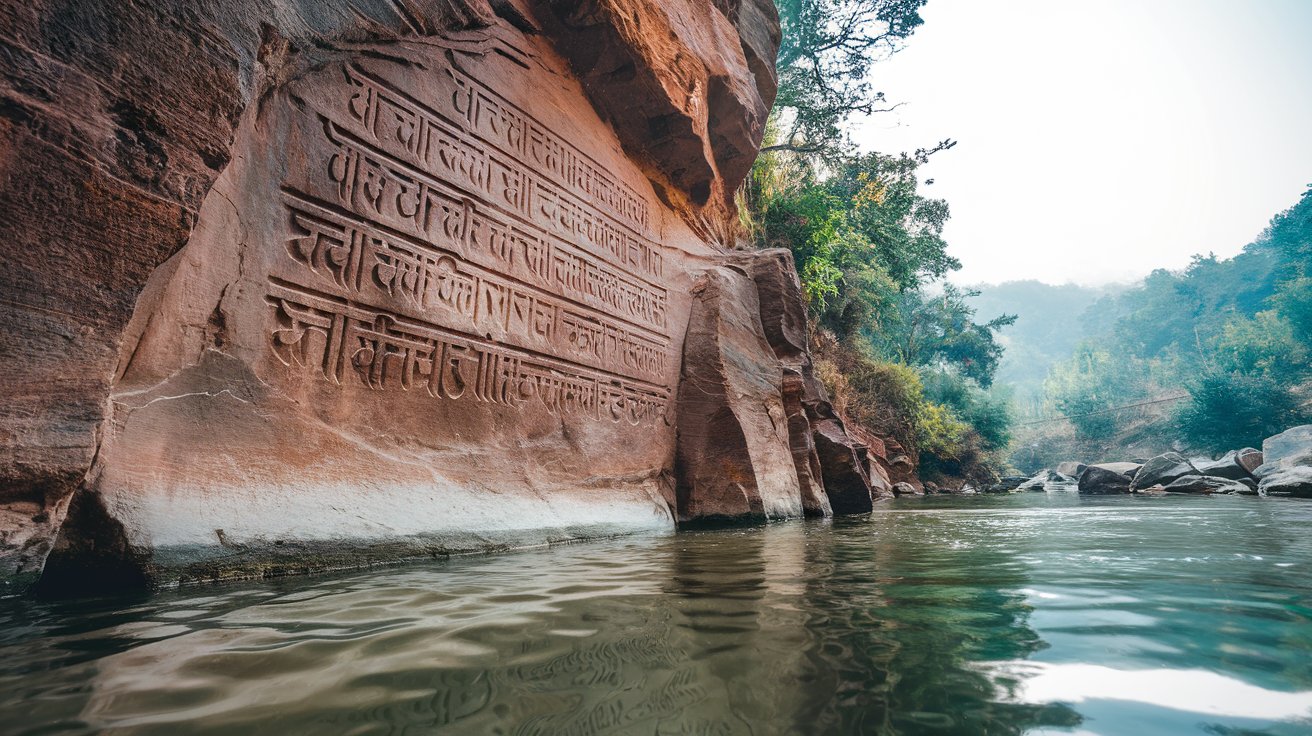
What makes the Indus Valley Script so mysterious? The Indus Valley Script, also known as the Harappan script, remains one of the most enigmatic writing systems from ancient times. Flourishing between 3500 BCE and 1900 BCE, this script has yet to be fully deciphered, leaving scholars puzzled about its language, purpose, and significance. With over 400 distinct symbols found on various artifacts, the script's brevity and symbolic nature add to the challenge. Despite extensive research and numerous theories, the lack of bilingual inscriptions has kept the script's secrets locked away. Join us as we delve into 35 intriguing facts about this ancient script and the civilization that created it.
Key Takeaways:
- The Indus Valley Script, an ancient writing system from 3500 BCE, remains undeciphered, with over 400 symbols and mysterious connections to other civilizations. Its decline and legacy continue to intrigue researchers.
- The Indus Valley Civilization was advanced in urban planning, trade, and art, leaving a rich cultural legacy. Despite ongoing mysteries, its technological achievements and peaceful society continue to inspire modern society.
The Enigmatic Indus Valley Script
The Indus Valley Script, also known as the Harappan script, remains one of the most mysterious aspects of the ancient Indus Valley Civilization. Flourishing from around 3500 BCE to 1900 BCE, this civilization left behind a script that has yet to be fully deciphered. Here are some fascinating facts about this ancient writing system.
-
Undeciphered Writing System
The Indus script is classified as an undeciphered writing system. Its meaning and language remain a mystery due to the absence of bilingual inscriptions. -
Discovery
The first publication of a seal with Harappan symbols dates back to 1875. By 1992, around 4,000 inscribed objects had been found, showcasing over 400 distinct signs. -
Symbolic Nature
Most inscriptions are very short, making it hard to determine if they recorded a language or symbolized words or ideas. -
Versatility
The script was versatile, likely used to communicate complex ideas and multiple languages. Its adaptability is evident from changes in writing over time.
Geographical Reach and Symbol Inventory
The Indus script wasn't confined to the Indus Valley. Its reach and the variety of symbols used are quite impressive.
-
Geographical Distribution
Inscribed objects have been found in distant areas like Mesopotamia, indicating trade and cultural exchange. -
Symbol Inventory
The script consists of over 400 distinct signs, including geometric shapes, animal motifs, and intricate designs. -
Right-to-Left Script
Primarily written right-to-left, some inscriptions show boustrophedon writing, where the direction changes with each line. -
Language Unknown
The language remains unknown. Scholars have proposed connections to Dravidian, Indo-Aryan, and other language families, but no definitive link has been established.
Connections and Decline
The Indus script has intriguing connections to other scripts and civilizations. Its decline is as mysterious as its origins.
-
Brahmi Script Connection
Some scholars suggest a connection between the Brahmi script and the Indus system. Raymond Allchin cautiously supports this possibility. -
Megalithic Graffiti Symbols
Symbols from southern and central India and Sri Lanka may overlap with the Indus symbol inventory, though they don't form a linguistic script. -
Unicode Encoding
Indus symbols have the ISO 15924 code "Inds." A proposal to encode the script in Unicode was submitted in 1999 but hasn't been approved. -
Indus Script Font
A font representing the Indus script was developed based on a corpus compiled by Asko Parpola. It was presented at an international conference in 2017. -
Decline of Writing
The civilization began to decline around 1800 BCE, including the disappearance of writing. The script perished along with the civilization.
Advanced Society and Urban Planning
The Indus Valley Civilization was advanced in many ways, from agriculture to urban planning.
-
Vedic Civilization
The Vedic civilization, which followed, did not use the Indus Script or have a writing system. Writing resurged almost a millennium later. -
Advanced Agriculture
The civilization engaged in extensive agriculture, thanks to rich soil and regular monsoon rainfall. They had advanced irrigation systems. -
Crop Rotation Method
Archaeological evidence suggests they used crop rotation to preserve soil fertility and prevent pests and illnesses. -
Sophisticated Urban Planning
Cities like Harappa and Mohenjo-Daro had cutting-edge urban design. Buildings were made of baked brick, and streets were grid-like. -
Drainage Systems
They had sophisticated drainage systems, public restrooms, and wells with pure water, showcasing superior engineering abilities.
Trade, Art, and Peaceful Society
The Indus Valley Civilization was not just advanced but also peaceful and artistic.
-
Trade and Commerce
Trade in commodities like cotton, gold, and precious stones was widespread. Harappa and Mohenjo-Daro were significant commercial hubs. -
Artistic Achievements
The civilization was renowned for intricate pottery, sculptures, jewelry, and stamps, often featuring geometric patterns and animal motifs. -
Seals
Seals made of steatite were used for marking property and goods. They often had intricate designs and inscriptions. -
Peaceful Society
Archaeologists believe the civilization was peaceful, with few signs of warfare or strife, unlike other contemporary societies. -
Organized Government
A highly organized government with a central authority likely supervised city management, reducing conflicts.
Decline and Legacy
The decline of the Indus Valley Civilization remains a topic of debate, but its legacy continues to influence modern society.
-
Decline and Disappearance
Around 1900 BCE, the civilization declined and vanished. Hypotheses include ecological factors, climate change, or invasion by outside forces. -
Internal Factors
Some scholars suggest internal factors like political instability or economic decline may have contributed to the civilization's fall. -
Symbolic Motifs
The unicorn symbol disappeared when the community using it lost power, indicating it wasn't widely cherished. -
Development of the Script
The script evolved from early potters' marks and geometric seals to animal motifs with signs above them, reflecting cultural changes. -
Place Names and Geographical Regions
Several major language families, including Dravidian, Mundari, Indo-Aryan, Sino-Tibetan, and a "language X," were likely present during the Indus cities' period.
Artistic and Technological Achievements
The Indus Valley Civilization's artistic and technological achievements were remarkable, showcasing their expertise in various fields.
-
Role in Trade
Seals played a significant role in trade, marking goods and property. Their intricate designs indicate their economic importance. -
Artistic Significance
Pottery, sculptures, jewelry, and stamps display a high level of artistic achievement and technique. -
Expertise in Metalwork
The civilization excelled in bead-making and metalwork, displaying advanced techniques and aesthetic value. -
Archaeological Discoveries
Archaeologist Sir John Marshall remarked on the sophistication of the civilization's artifacts and urban planning, finding it hard to believe they were prehistoric. -
Cultural Legacy
The civilization left a rich cultural legacy that continues to influence contemporary Indian society. -
Research and Studies
Recent technological developments have allowed for a more detailed examination of the script. Scholars like Asko Parpola and Iravatham Mahadevan have provided comprehensive analyses. -
Ongoing Mysteries
Despite extensive research, many mysteries surrounding the Indus script remain. The lack of bilingual inscriptions and significant changes over time continue to pose challenges for deciphering the script.
The Enigma of the Indus Valley Script
The Indus Valley Script remains one of history's greatest mysteries. Despite extensive research, scholars haven't cracked its code. This ancient writing system, with over 400 distinct signs, offers a glimpse into a civilization that thrived from 3500 BCE to 1900 BCE. Found on seals, pottery, and other artifacts, these symbols hint at a complex society engaged in trade, agriculture, and urban planning. The script's versatility and widespread use suggest it played a crucial role in daily life. Yet, without bilingual texts, its meaning eludes us. Advances in technology and ongoing studies provide hope that one day we'll understand this script. Until then, the Indus Valley Script stands as a testament to the ingenuity and mystery of an ancient civilization. Its secrets continue to captivate researchers and history enthusiasts alike, keeping the quest for knowledge alive.
Frequently Asked Questions
Was this page helpful?
Our commitment to delivering trustworthy and engaging content is at the heart of what we do. Each fact on our site is contributed by real users like you, bringing a wealth of diverse insights and information. To ensure the highest standards of accuracy and reliability, our dedicated editors meticulously review each submission. This process guarantees that the facts we share are not only fascinating but also credible. Trust in our commitment to quality and authenticity as you explore and learn with us.


